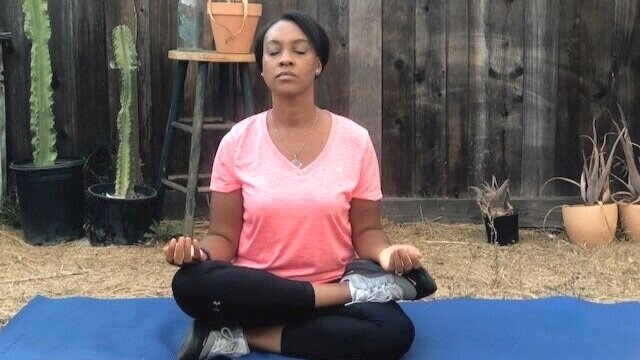HOW DO YOU ACTUALLY MEDITATE?
A Practical Guide To Mindfulness Meditation
And why it’s so important right now..
An interview with Rev. Jim Burklo of USC
Meditation always sounds like a great idea! It wasn’t until the pandemic hit that it went from an esoteric idea to something that I do daily. As a multitasking mom of two young children, ‘free time,’ is rare. With lockdown now the way of life, we all rely upon each other more than ever before. I want to be my most present and available self for my family. Prayer and meditation has leveled me out, allowing me to move through this time with more clarity and ease.
With most new things, there’s always the question of “Am I doing this right?” While the healing benefits of meditation are widely praised, at first the practice felt very mystical to me. I wanted to crack the code! So, I reached out to Reverend Jim Burklo, the Senior Associate Dean of Religious and Spiritual Life at the University of Southern California and a teacher at Mindful.USC.edu. He practices Mindfulness Meditation regularly. While the concept of mindfulness comes from Buddhism, mindfulness meditation is a secular practice. Rev. Jim describes it as:
“Watching your thoughts and emotions in the moment with and attitude of love and acceptance.”
How do you begin the process of Mindfulness Meditation?
There’s many ways to do it. Rev. Jim says it depends on what’s comfortable for you. Whether it's 20 minutes daily or meditating in short bursts throughout the day, you can still get the benefits.
One of the most effective ways to start a meditation practice is by tagging it on to something that you DO already.
If you exercise, tag it onto that. If you pray in the morning, meditate after. If your bathroom is your main place of solace, (parents, you feel me), add it there. Rev. Jim practices mindfulness on his daily 3-mile walk in the Ojai mountains, close to his home. “I walk my bicycle up a hill, push it uphill. Stop, do my practice. Then turn it around, roll back home...Twice the benefit you might say.” Even if you don’t have a mountain, ashram or even a yoga mat nearby, it’s all good! Rev. Jim says that is not the point. Sit in a chair at home in your PJs if you want. The most important thing is to come as you are.
“We have a lot of images in our head about what meditation is supposed to look like, and I say give that up. None of that matters.”
Rev. Jim Burklo, USC
While it may feel nice to meditate alone, it’s OK if you can’t sit quietly without the kids running around or without interruption. “The noise outside is just reflective of the noise in your head,” Rev. Jim explains, adding that mindfulness is about looking at what IS, seeing your mind in real time in a way that allows you to look at your thoughts and emotions in the moment, without judgement.
It’s NOT about trying to block out uncomfortable or weird thoughts while meditating. It’s about observing them with awareness, so that they’re acknowledged and, in a way, out in the open.
“Our minds are all over the place, they’re everywhere...You’re not trying to change or fix anything or improve your thoughts or emotions. It’s not about problem solving either. It’s about attending to them. It’s about watching the thoughts, as they are and letting them be. What is my emotional state? What physical sensations am I sensing? What narratives are running in my mind? This process is about the refinement and re-trainment of attention. It’s the attention that is love. Love and attention are the same thing,” Rev. Jim explains.
The focus on re-training our minds to be more attentive, and therefore more loving is something that’s also helpful when parenting through times of great change.
Burklo, who is also a father himself, says that the best thing that parents can do for their children is give them attention, even when they’re tantruming or acting nutty. He adds, “(I) may not be able to fix it for them but can sit there with them and just listen.”
The best way to include your children into your mindfulness meditation practice is by teaching them the basics.
It’s as simple as encouraging your child to sit and watch their feelings and bodies. Ask them about what they’re feeling or experiencing.
“Once you get them started, the foundation will be set for a deeper level of communion with God. It’s all interconnected.”
-Rev. Jim Burklo
If you’re a person of faith, Rev. Jim says that meditation and prayer go hand in hand. It all flows back to God.
“Attention = Love. Love = God. So when you’re fully attending, then you are one with God.”
Meditation is a practice that can be traced back to ancient religious prayer practices, observed by both Buddhist and Christian monks. When you’re meditating and observing everything about yourself-your body, your mind, the way you relate to the rest of the world, you’ll get to a point where you wonder who is actually doing the watching? “Is the watcher the same as that which is watched? That’s the awakening moment! There’s no thing that’s doing the watching,” he shares. The Buddhist answer is that the watcher is pure consciousness and awareness.” Christians call the watcher God. “It’s Christ who lives within me. Christ is doing the seeing through me...That’s the moment of union with the divine, where prayer and mindfulness come together—same thing!” the Reverend says. For Hindus, the sound of “Om” means God. When you’re chanting the Om, you are channeling god. That’s God coming through you. It’s also very Christian, because we have “Amen.” That may very well linguistically be related to Om.
So, if God’s watching, shouldn’t we be more aware of our thoughts?
Quoting an early monk, Rev. Burklo simply says no.
“Thoughts are not the problem. It’s what we do with the thoughts. By our thoughts we can be crowned, or by our thoughts we can be shipwrecked.”
“We’ve got to know what we’re thinking in order to make that distinction. God is love. The Greek word is Agape. Agape love is unconditional love,” Rev. Jim says, adding, “So love no matter what. If you have a weird thought, love it. Agape that thought. After you have seen, with fullness and the reality of what is, with agape love, then you can deal. If there’s something to correct, you know what needs to be corrected. But you’re not going to know that unless you’ve seen it without judgement, without criticism, without filters...that’s the heart of mindfulness work.”
It’s NOT About the Results
Lots of research points to the effectiveness of meditation on physical health, which can include reducing your blood pressure and cortisol levels, which can help your body respond to stress, fight infection, and more. There’s also tons of mental health benefits too, especially around anxiety reduction. But when it comes to doing the practice, there’s no sure time as to when stress-free living will “kick in.” One thing that Rev. Jim wants to make clear is that the practice of Mindfulness Meditation is an end in itself. The purpose of mindfulness is mindfulness.
From the moment you start, meditation is proven to shorten the half life of emotions, he says, which is a huge benefit alone.
There’s so much happening right now. From covid, to politics—to the fight for justice. How do get a better hold of things so that you can better support yourselves and family? How can one maintain their spiritual equilibrium during this time?
“Pray and act. Act and pray. Pray while you work, pray so that you can work.”
The power of meditation to shorten the life of our emotions means that we’re able to not be controlled by them, which Rev. Jim says, helps us be a lot more useful in the work to end racism and prevent authoritarianism. If the goal is to “change the system,” he says, “We’re going to mess up if we don’t have our heads and our hearts together...That’s where having some sort of spiritual discipline is a big deal. Meditation practice is a big deal in this time. Now is the time to...double down.




